#Also while capitalism is often linked with/the source of hyper productivity culture - note that I do not mean the images in that context
Text




I find it kind of silly that so many of those "time based life rule" sayings are like ~deep serious guidelines~ of some sort, but then there's that one other Well Known Rule that's just like "hrmm can I eat something off of the ground or not"
#the duality of human condition.. two biggest concerns in the modern era are attempts at self fulfilling productivity#and also 'if i drop my sandwich can i still eat it :('#Also while capitalism is often linked with/the source of hyper productivity culture - note that I do not mean the images in that context#'meaningful to you' does not have to mean 'productive within a capitalist system'. The point is not 'every waking hour of every day#must be spent in the most societally productive grinding mindset hyper efficency mode possible' but more like#if you've always wanted to learn french ever since you were a kid and you think it would be fulfilling to you (just because you like it#absent of any larger purpose like using it for a job/monetizing it somehow/etc.). and you've just spent like 5 hours straight on tiktok#or something mindlessly scrolling the internet. maybe someimtes it'd help for your own personal fulfillment in the long#run to try to - the next time you have 5 spare hours - work on learning french or something that is actually significant to you#as a person and that you'll be glad you worked towards. instead of weeks and weeks passing by and feeling you have nothing to show for it#or etc. AAANYWAY. The images/rules themselves are also NOT the main point of this post. More just the juxtaposition of them together#and the fact that 3 of them are serious seeming while one is so mundane it seems silly in comparison.#BUT even though they're not the main point . I still didn't want it to come across as if I was like promoting or buying into capitalist#productivity culture propaganda or etc. I don't find productivity tips like this inherently bad as long as they're kind of divorced from#those ideas. I think it's still important in life to have goals even if those goals exist outside of the typical expected framework.#I mean that's actually part of why a culture of chronically exhausted overworked deprived people is damaging because if you#'re forced to spend 85% of your waking time working at some job that is perosnally meaningless to you that brings you nothing that#youre only doing under threat of starvation and houselesness and etc. then of course you don't have much time for hobbies or things you car#about and of course you'll feel more aimless and personally unsatisfied and like life is not fulfilling or interesting.#Productivity and efficiency is GOOD actually. as long as it's able to be directed in ways that are actually meaingful to the community or#individual and bring some sort of feeling of fulfillment or progress or accomplishment and working towards a person's personal ideas#of happiness whatever those are. rather than just working away aimlessly so some guy you don't know can buy a 20th house or etc. etc.#ANYWAY.. lol.. Me overthinking things perhaps.. probably not as likely#that people see the silly little cat images and go 'WOW EVIL you must be a capitalist grind culture lover' like its pretty clear#thats not the point... but... just in case... lol.. I loooove to over clarify things that don't actually need clarification
22 notes
·
View notes
Text
The Brutalism Post, Part 2: What Brutalism is Not
Why open a series about Brutalism by discussing what is not Brutalism? The answer is simple: of all of the terms in the history of architecture, Brutalism is perhaps the most misused and misunderstood by the general public.

Pictured: Citizens Bank Tower, 1958-66. Not Brutalism (it’s just plain ol’ International Style modernism). Source
The main issue here, as we will discuss later, is not that people are ignorant for using the wrong definition of the word Brutalism, but that the word Brutalism has come to mean or refer to a variety of architectural phenomena that are linked to one another via overarching similarities, the most important being an expanded set of buildings that elicit a specific emotional response in the viewer.
“Brutalism”, a specific architectural movement with its own ideology and history, has come to encompass a wide range of colloquial meanings. Some of these meanings are common misconceptions that reflect a need for broader architectural education (the purpose of this series), and some of these meanings reflect a deeper, more philosophical, interrogation into how we perceive and discuss architecture and the complex emotions it arouses within us, exposing a need for new means of communicating a common architectural sentiment.
Let’s start with the most common misuse of the term.
Brutalism is not: every single building made primarily of reinforced concrete.
Blame this one on the dictionary. The term Brutalism, while being derived from the French term beton brut, meaning raw concrete, does not apply to all buildings made from reinforced concrete. Developed in the 1870s, reinforced concrete is one of the most commonly used building materials in the world. Because of its inexpensive price, its structural integrity, and its ability to be cast into a variety of shapes and forms, many buildings were - and continue to be - made from it.
Let’s look at three examples of buildings I have found labeled “brutalist” in various places.
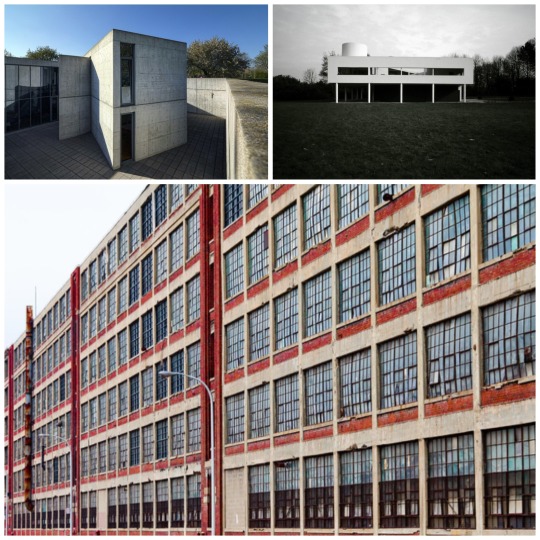
Not Brutalism: (from left to right): Tadao Ando, Vitra Conference Center (1993) Photo by Wojtek Gurak (CC BY NC 2.0); Le Corbusier, Villa Savoye (1929) Photo by Scarlet Green (CC BY 2.0); Albert Kahn, Highland Park Ford Factory (1910) Photo by Thomas Hawk (CC BY NC 2.0)
All of these buildings are constructed primarily from reinforced concrete. As you can see, they are all very, very different from one another. In these three cases, the key piece of information discrediting these buildings as being Brutalist is when they were built. Brutalism was a specific architectural movement from spanning a defined period of time (1940s-late 1970s). Buildings constructed outside of this time window are rather unlikely to be Brutalist.
Let’s look at why these buildings might be mislabeled brutalist.

Our first example is the Vitra Conference Center by Tadao Ando, which was built in 1993. Even though 1993 is far outside the time frame that brutalism spanned, this building has many characteristics that are “brutalistic,” specifically its extensive use of unpainted reinforced concrete, its heavy, geometric massing, and its intense visual weight. Ando’s architecture falls under the term “critical regionalism” - which is best understood as being modern in form (but not in dogma), with a heightened focus on the surrounding ecology and landscape as well as other geographical, cultural, and social contexts.

The Villa Savoye by Le Corbusier, finished in 1929, is one of the most iconic 20th century houses and works of modernist architecture in the world. This house, though made of reinforced concrete, belongs to the movement known as the International Style, which was developed in Western Europe after World War I, is known for its rejection of ornament, flat surfaces (especially roofs), extensive use of glass, and visually lightweight and repetitive forms. While the International Style makes use of concrete, it differs from Brutalism in its visual lightness - the Villa Savoye seems to float effortlessly above the landscape - very unlike Brutalist architecture, which is characterized by its massive scale, hulking forms and visual heaviness.
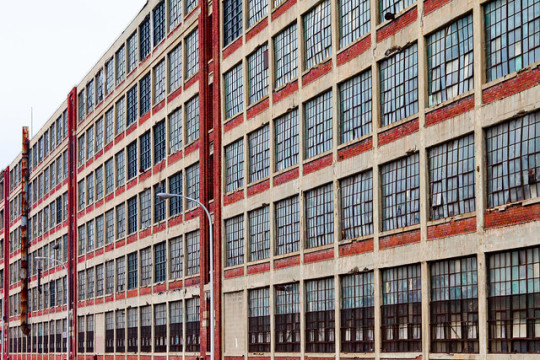
The Highland Park Ford Plant, built in 1910 by noted factory architect Albert Kahn, was once the premiere factory building in America, helping to advance not only the Fordist system, but the city of Detroit, Michigan as being the automobile capital of the world. It is a touchstone of factory design, notable for its pioneering use of the assembly line to facilitate mass production, a concept that remains central to factory design today. Although made of reinforced concrete, the Highland Park plant is not a brutalist building. It frequently is mischaracterized as being brutalist because of its massive side, imposing features, and the close association that has developed between brutalist architecture and urban exploration photography (More on this later).
TL;DR: All brutalist buildings are made of reinforced concrete (or heavy masonry), but not all reinforced concrete buildings are brutalist. Moving on.
Brutalism is not a catch-all term for Late Modernist architecture
Architecture got so weird and complicated in the period from the 1960s through the early 1980s that it inspired the architectural theorist Charles Jencks to create the first of several delightful and mind-bending charts to try and categorize it:
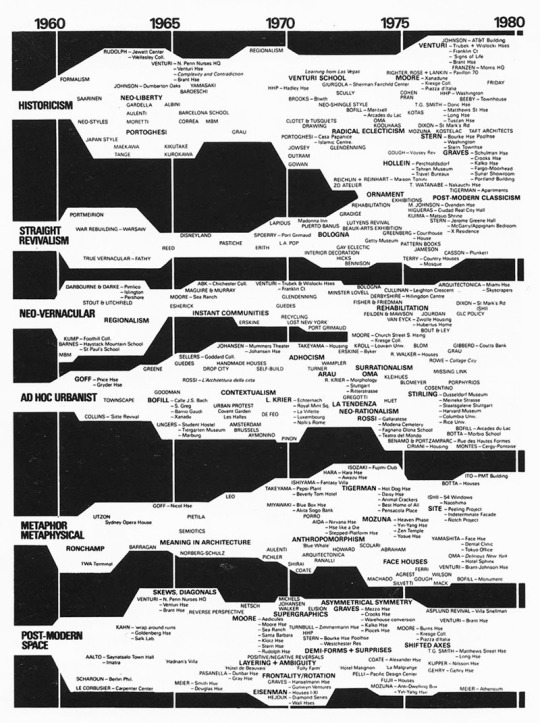
Yeah.
What is Late Modernism? The concise definition is that it is an umbrella term encompassing the various architectural movements that transpired after International Style/Mid-Century Modernism but before Postmodernism. (For more on what Late Modernism is and why you should care, see my post from 2016.) Brutalism elides with Late Modernism, but not all Late Modern buildings are Brutalist. Because Brutalism is contemporaneous with Late Modernism, the distinction can be confusing. Often the case is that Late Modern buildings that are described as ‘Brutalist’ should be recategorized or reassigned to a different, equally obscure and hyper-specific architectural sub-movement happening around the same time. This might seem nitpicky, but look on the bright side: now you get to correct your friends.
Late Modernism encompassed a lot of smaller architectural movements, most, but not all of them ending in -ism. Some, like Brutalism and High Tech, are more well known; others, like Metabolism, Structuralism, Critical Realism, and Neo-expressionism, not so much. Some buildings don’t fit into any of these categories and must (frustratingly) be referred to as simply “Late Modern” or “Transitional” (referring to the transition from Modernism to Postmodernism.)
Here are three Late Modern buildings that are not Brutalist:
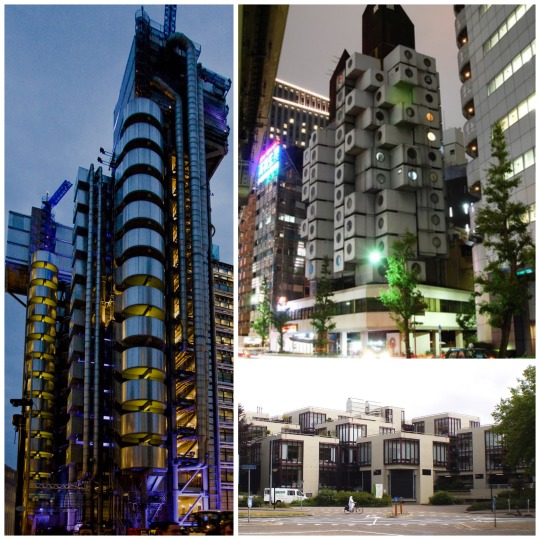
Left: Richard Rogers, Lloyd’s Building (1986) Photo by Lloyd’s Insurance (CC BY 2.5); Top Right: Kisho Kurakawa Nakagin Capsule Tower (1972) Photo by scarletgreen (CC BY 2.0); Bottom Right: Herman Hertzberger, Centraal Baheer (1972) Photo by Apdency (CC BY-SA 3.0)

Lloyd’s Building, the headquarters of Lloyd’s of London, located in, unsurprisingly, London, was designed by Richard Rogers and completed in 1986. Despite the relative lack of reinforced concrete, the building is frequently categorized as being Brutalist. The fact that it lacks reinforced concrete as a defining architectural feature is all one needs to eliminate Lloyd’s from the Brutalism category - why it is put there in the first place we will discuss more in depth in the next section of this post. Lloyd’s - along with most of Rogers’ work - is part of the architectural movement known as “High Tech” because it is, well, High Tech.
High Tech buildings are the apogee of the modernist mindset in terms of glorifying the functions of a building and the technological elements of structural engineering. They take what are usually internal systems such as structural frames, circulation systems (such as stairs and elevators) and services (electrical, plumbing, etc) and integrate them into their external architectural form. (Lloyd’s is colloquially known by Londoners as the “inside out building”). High Tech was relatively short lived because it turns out that when you decorate the outside of your building with its internal services, when winter comes, your water pipes, exposed to the elements, tend to freeze.

The Nakagin Capsule Tower, built in 1972 by Japanese architect Kisho Kurakawa (one of my favorite architects ever who more people should know about), is one of the buildings most commonly labeled as Brutalist. This building illustrates the gray area that arises when one uses vague aesthetic attributes (concrete, visually heavy, geometric massing) to designate a building as Brutalist instead of the actual history and context of the building in question. The Nakagin Capsule Tower belongs to a different (if coexistent) architectural movement that, frankly is a lot weirder than Brutalism: Metabolism. Take the formal concept of organic biological growth and systems and combine it with the urbanistic concept of megastructures (an entire city contained in a single continuous structure or via several interconnecting structures) and you get Metabolism. Because of the practical issues with building an entire city within a single building, Metabolism lived mostly on paper, however a few built examples were executed, the most famous being the Nakagin Capsule Tower.

The Centraal Baheer office building was built by Dutch architect Herman Hertzberger in 1972. Like the Nakagin Capsule Tower, it satisfies many of the aesthetic signifiers commonly attributed to Brutalism: it’s made of reinforced concrete, composed of large geometric massing, and it’s visually heavy. Also like the Nakagin Capsule Tower, it belongs to a different, coexisting architectural movement, primarily developed by the Dutch, called Structuralism. Structuralism is a complex set of architectural ideologies developed in the 1960s and 70s, centered around a few key concepts: the rationalist idea that people’s behavior can be directly changed (or manipulated) via design; designing built structures that correspond in form to social structures; an emphasis on cultural and geographical context; an urbanism and design approach based, like Metabolism, on a biological growth analogy (called Aesthetics of Number); the integration of a variety of uses and programs within the same overall structure; and, finally, the aim to architecturally reconcile the needs of both “high” and “low” culture.
Brutalism, Metabolism, and Structuralism arose from a similar origin, and are ideologically more alike than different, something we will talk about in the next installment of this series.
Brutalism is not a feeling.
But also, it kind of is. It is, as the folks say, “a big mood.” A large reason why buildings are incorrectly labeled Brutalist is because they bring forth a very specific emotional response to architecture shared by many people across the world. Some of the buildings that cause people to feel this complex and nuanced set of emotional and aesthetic reactions are, in fact, Brutalist, but many are not. To me, what this demonstrates, is a broader need for architectural education and discourse that goes beyond the most common system for classifying architecture: stylistic labels.
To talk about this, we’ll bring back Lloyd’s Building, Kahn’s factory and present it alongside a few other examples.


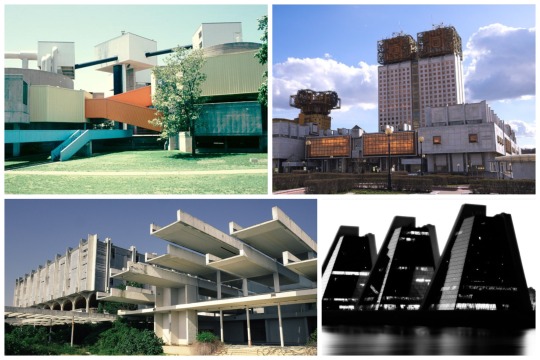
Left to Right: John M Johanson, Stage Center Oklahoma City (1979) Photographer unknown; Yuri Platonov, Russian Academy of Sciences (1968) Photo by Raita (CC BY 2.0); Boris Magasto, Haludovo Hotel, Krk, Croatia (1972) Photographer unknown; Kevin Roche, The Pyramids (1972) Photo by jikatu (CC BY SA 2.0)
All of these buildings (and all of the photographs of these buildings) are very different from one another, and yet, they have all been classified mistakenly as being “Brutalism.” The only real link between them is emotion.
Like many folks in the late aughts/early 2010s, I nurtured my then-juvenile love of architecture through spending hours lurking in the Skyscraper City forums looking at thread after thread of pictures of 20th century architecture. Why? Because those images made me feel powerful emotions that I still find difficult to put into words.
When talking about Brutalism as a feeling, perhaps the closest idea comes from the English philosopher Edmund Burke in his 1756 treatise “A Philosophical Enquiry into the Origin of our Ideas of the Sublime and Beautiful”. I am, of course, talking about the sublime. The Burkean sublime is emotionally complex. To quote Burke directly:
“Whatever is fitted in any sort to excite the ideas of pain, and danger, that is to say, whatever is in any sort terrible, or is conversant about terrible objects, or operates in a manner analogous to terror, is a source of the sublime; that is, it is productive of the strongest emotion which the mind is capable of feeling.”
But the sublime isn’t just negative. It overwhelms us with its awesome power and in this moment, “the mind is so entirely filled with its object, that it cannot entertain another.” Burke’s concept of the sublime was initially applied to such things as the ocean or the Alps - natural features that are so large, massive, and inherently dangerous that they put us in a state of awe-inspiring disbelief - and yet, and despite their mass and their danger, they give us feelings of deep pleasure and joy.
To the people (including myself) who love Brutalism - it does engender feelings of unknowing, of mystery, and sometimes, especially when said Brutalist building is in disrepair or photographed at a particularly menacing angle, of fear or grief. It shares this, rather than a stylistic label, with the buildings featured in this post.

Because of Brutalism’s association with the State, such as in the case of the former Soviet Bloc, East Germany, the welfare state in England, or its use in governmental buildings around the world, lingering political sentiments can also contribute to this complex mix of emotions - whether one longs for the halcyon days of eras past or fears them as being domineering or totalitarian. It can also cause people to associate buildings that are not Brutalist with buildings that are because they share a same political history. Similar to how the post-industrial society left behind a trail of industrial ruins along the American Rust Belt, so too has neoliberalism gutted and left for dead the monuments of these modernist utopias.

An actual Brutalist building: Paul Rudolph, Endo Laboratories Headquarters (1964). Photo via Library of Congress
Brutalist or not, these are enigmatic buildings - their forms are strange and unusual, alien even; their contents and even their purposes remain mysterious. Their siting makes them seem either imposing relative to their surroundings or isolated and alone. There is something dark and lonely, sad and longing about them. They are beautiful, partially because of their striking, form-bending architecture, and partially because they once lived different lives in times so unlike ours.
If you like this post, and want to see more like it, consider supporting me on Patreon!
There is a whole new slate of Patreon rewards, including Good House of the Week, Crowdcast streaming, and bonus essays!
Not into recurring donations or bonus content? Consider the tip jar! Or, Check out the McMansion Hell Store! Proceeds from the store help protect great buildings from the wrecking ball.
Copyright Disclaimer: All photographs are used in this post under fair use for the purposes of education, satire, and parody, consistent with 17 USC §107. Manipulated photos are considered derivative work and are Copyright © 2019 McMansion Hell. Please email [email protected] before using these images on another site. (am v chill about this)
#architecture#design#architectural history#brutalism#late modernism#structuralism#metabolism#modern architecture
4K notes
·
View notes